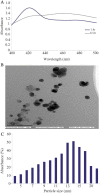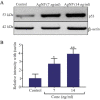β-sitosterol Mediated Silver Nanoparticles Induce Cytotoxicity in Human Colon Cancer HT-29 Cells
- PMID: 33680372
- PMCID: PMC7903430
- DOI: 10.18502/ajmb.v13i1.4577
β-sitosterol Mediated Silver Nanoparticles Induce Cytotoxicity in Human Colon Cancer HT-29 Cells
Abstract
Background: Silver nanoparticles (AgNP) are commonly used metallic nanoparticles in health care systems. Colon cancer incidence is increasing worldwide. In this study, AgNP was synthesized using β-sitosterol and its cytotoxic potential was evaluated in human colon cancer (HT-29) cells.
Methods: Characterization of AgNP was analyzed by TEM and spectrophotometry analysis. HT-29 cells were treated with different concentrations (2, 4, 6, 8 and 10 ng/ml) of AgNPs and cytotoxicity was evaluated by MTT assay. The apoptosis was analyzed by the flow cytometry. The expression of p53 protein was analyzed by western blotting.
Results: β-sitosterol mediated AgNP are spherical in shape and induced concentration-dependent cytotoxicity in HT-29 cells. AgNP caused apoptosis related morphological changes as evidenced by annexin positive staining. AgNP treatments also induced the p53 expression in HT-29 cells.
Conclusion: Our present result suggests that β-sitosterol mediated AgNP induce apoptosis in colon cancer cells and this finding may pave the way for further experimental analysis in vivo.
Keywords: Apoptosis; Colon neoplasms; HT29 cells; Silver nanoparticles; β-sitosterol.
Copyright© 2021 Avicenna Research Institute.
Conflict of interest statement
Conflict of Interest The authors declare they have no conflict of interest.
Figures







Similar articles
-
β-Sitosterol-assisted silver nanoparticles activates Nrf2 and triggers mitochondrial apoptosis via oxidative stress in human hepatocellular cancer cell line.J Biomed Mater Res A. 2020 Sep;108(9):1899-1908. doi: 10.1002/jbm.a.36953. Epub 2020 Apr 30. J Biomed Mater Res A. 2020. PMID: 32319188
-
Cytotoxic potentials of silibinin assisted silver nanoparticles on human colorectal HT-29 cancer cells.Bioinformation. 2020 Nov 30;16(11):817-827. doi: 10.6026/97320630016817. eCollection 2020. Bioinformation. 2020. PMID: 34803254 Free PMC article.
-
Silver nanoparticles of Albizia adianthifolia: the induction of apoptosis in human lung carcinoma cell line.J Nanobiotechnology. 2013 Feb 18;11:5. doi: 10.1186/1477-3155-11-5. J Nanobiotechnology. 2013. PMID: 23418790 Free PMC article.
-
Biogenic Synthesis, Characterization and Evaluation of Silver Nanoparticles from Aspergillus niger JX556221 Against Human Colon Cancer Cell Line HT-29.J Nanosci Nanotechnol. 2018 May 1;18(5):3673-3681. doi: 10.1166/jnn.2018.15364. J Nanosci Nanotechnol. 2018. PMID: 29442882
-
Assessment of MMP29 Gene Expression and Silver Nanoparticles Effects on Colon Cancer Cell Line (HT29).J Gastrointest Cancer. 2020 Jun;51(2):560-563. doi: 10.1007/s12029-019-00289-8. J Gastrointest Cancer. 2020. PMID: 31407249
Cited by
-
Research progress of ginseng in the treatment of gastrointestinal cancers.Front Pharmacol. 2022 Oct 12;13:1036498. doi: 10.3389/fphar.2022.1036498. eCollection 2022. Front Pharmacol. 2022. PMID: 36313365 Free PMC article. Review.
-
Boldine Treatment Induces Cytotoxicity in Human Colorectal Carcinoma and Osteosarcoma Cells.Cureus. 2023 Nov 1;15(11):e48126. doi: 10.7759/cureus.48126. eCollection 2023 Nov. Cureus. 2023. PMID: 38046745 Free PMC article.
-
Fungal-Mediated Silver Nanoparticle and Biochar Synergy against Colorectal Cancer Cells and Pathogenic Bacteria.Antibiotics (Basel). 2023 Mar 16;12(3):597. doi: 10.3390/antibiotics12030597. Antibiotics (Basel). 2023. PMID: 36978464 Free PMC article.
-
β-Sitosterol-Dietary sources and role in cancer and diabetes management.Food Sci Nutr. 2024 Sep 11;12(11):8870-8886. doi: 10.1002/fsn3.4380. eCollection 2024 Nov. Food Sci Nutr. 2024. PMID: 39619995 Free PMC article.
-
Salvia chinensis Benth Inhibits Triple-Negative Breast Cancer Progression by Inducing the DNA Damage Pathway.Front Oncol. 2022 Aug 10;12:882784. doi: 10.3389/fonc.2022.882784. eCollection 2022. Front Oncol. 2022. PMID: 36033499 Free PMC article.
References
-
- Shi C, Wu F, Zhu XC, Xu J. Incorporation of beta-sitosterol into the membrane increases resistance to oxidative stress and lipid peroxidation via estrogen receptor-mediated PI3K/GSK3beta signaling. Biochim Biophys Acta 2013;1830(3):2538–44. - PubMed
LinkOut - more resources
Full Text Sources
Research Materials
Miscellaneous
